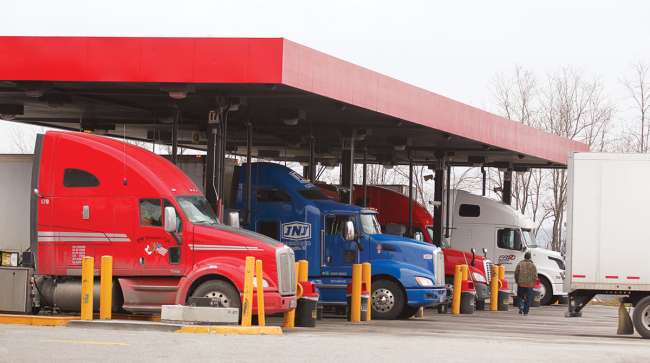Senior Reporter
Diesel Rises 0.6¢ to $3.344 a Gallon

[Stay on top of transportation news: Get TTNews in your inbox.]
The national average price of diesel increased six-tenths of a cent to $3.344 a gallon, the second rise of less than a penny in as many weeks, according to Energy Information Administration data released July 19.
Trucking’s main fuel has increased in price for 12 consecutive weeks, totaling 22 cents, since May 3.
Diesel now costs 91.1 cents more than it did at this time a year ago.
U.S. average on-highway #diesel fuel price on July 19, 2021 was $3.344/gal, UP 0.6¢/gallon from 7/12/21, UP 91.1¢/gallon from year ago https://t.co/GvzqFaQ7v5 #truckers #shippers #fuelprices pic.twitter.com/LOUyBs1Dks — EIA (@EIAgov) July 20, 2021
The average diesel price rose in seven of the 10 regions in EIA’s weekly survey, with the biggest gain being 4 cents in the Rocky Mountain region. The price dipped two-tenths of a cent in the Lower Atlantic and was unchanged in the East Coast and Gulf Coast.
The average price of gasoline rose 2 cents to $3.153 and is 96.7 cents a gallon higher compared with the 2020 period.
Meanwhile, in South Dakota on July 17, Gov. Kristi Noem signed an emergency executive order granting extended hours of service for the commercial delivery of petroleum products in the state through Aug. 16 — as residents and businesses in western South Dakota face an unexpected shortage of supply.
“We are at the height of our tourism season, as well as a busy time for our agriculture industry. Maintaining the supply of fuel is crucial to preventing a disruption of service to two of our state’s major industries,” said Noem. “This 30-day order is meant to ensure a steady supply of fuel is available to our visitors, businesses, farmers and ranchers in the western part of the state.’’
Today I signed Executive Order 2021-10 waiving regulations related to transportation of petroleum products due to an unexpected fuel supply shortage in western South Dakota. Read more here: https://t.co/yntmIhbv0e — Governor Kristi Noem (@govkristinoem) July 17, 2021
The governor called the fuel shortage not just an issue within South Dakota, but a regional emergency.
Her order declares a state of emergency and exempts delivery of gasoline, diesel, jet fuel and ethyl alcohol from federal motor carrier regulations on drivers’ hours of service.
A release from the governor’s office noted although hours of service have been temporarily suspended for commercial deliveries, companies may not require or allow fatigued drivers to make deliveries.
With diesel prices climbing, trucking industry consultant Kevin Otto told Transport Topics one of the best things a fleet can do to improve its fuel performance is just get a new engine in a new truck, because the new ones are significantly better than those purchased five years ago.
And it’s not just the engines.
The vehicles are better, too, he added, including aerodynamic features. “But you have factors with that as to which features make the most sense for what fleets.”
As for redesigned cleaner and more efficient engines likely coming in 2027, Otto said there is a long list of steps in the works to improve the combustion process and the air handling systems, and include a “mild hybrid feature” that involves putting a 48-volt battery system that can add to the propulsion of the engine/transmission system.
“The trick there is to figure out how to capture energy during downhill operation and braking,” he said, “then stuff that energy into the battery and use it to improve the fuel economy the engine is running at.”
Also, EIA reported U.S. production capacity for renewable diesel “could increase significantly through 2024,” citing announced projects and those that are under construction.
“Growing targets for state and federal renewable fuel programs and incentives for renewable diesel production are driving this expansion,” it added.
This comes as the world’s biggest oil and gas companies are more likely to talk to Wall Street about emissions than how their businesses might grow, according to Bloomberg News.
U.S. average price for regular-grade #gasoline on July 19, 2021 was $3.153/gal, UP 2.0¢/gallon from 7/12/21, UP 96.7¢/gallon from year ago https://t.co/fkAusasZtq #gasprices pic.twitter.com/BguQTnFwv5 — EIA (@EIAgov) July 20, 2021
During the fossil-fuel giants’ earnings calls the word “carbon” was uttered 800 times, exceeding the 790 mentions of “growth” for the first time ever. References to words tied to energy transition so far this year have already outnumbered those for all of 2020, Bloomberg reported.
West Texas Intermediate crude futures on the New York Mercantile Exchange closed at $66.42 per barrel on July 19 compared with $74.101 on July 12.
EIA noted U.S. petroleum refineries produce about 11 to 12 gallons of ultra-low sulfur distillate fuel oil (most of which is sold as diesel fuel and in several states as heating oil) from one 42-gallon barrel of crude oil, and also 19 to 20 gallons of motor gasoline.
Refinery yields of individual products vary from month to month as refiners focus operations to meet demand for different products and as they work to maximize profits, according to EIA.
As for refinery capacity, EIA’s annual Refinery Capacity Report found the beginning of 2021 marks the lowest annual capacity figure to start the year since 2015. Based on information reported in its recent update, U.S. refining capacity will not expand significantly during 2021, EIA reported in July.
U.S. On-Highway Diesel Fuel Prices

EIA.gov
Want more news? Listen to today's daily briefing below or go here for more info:

